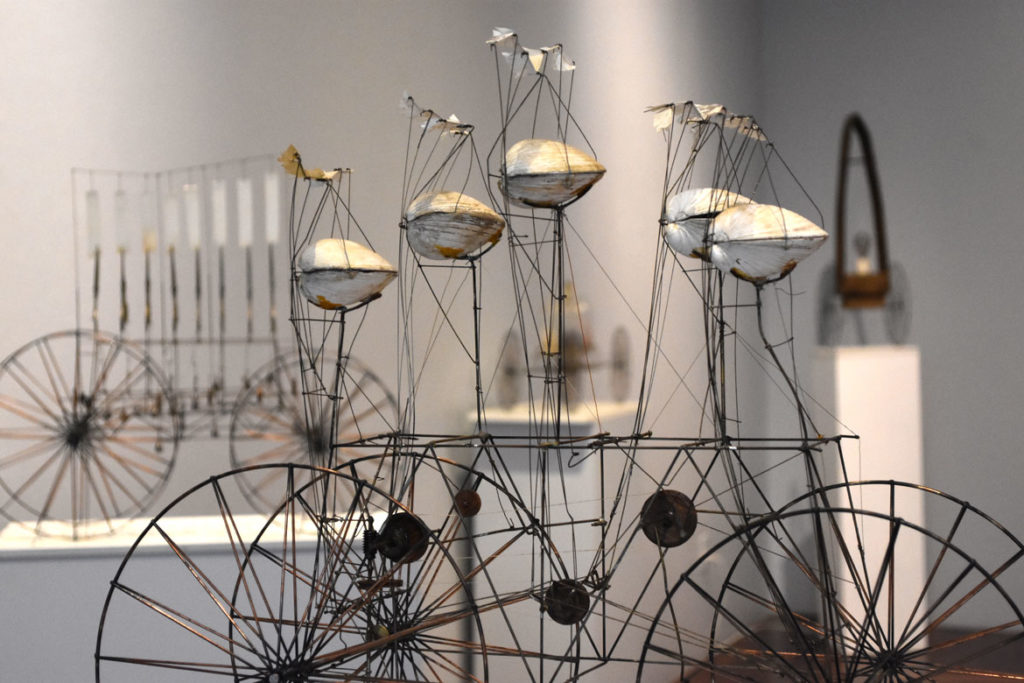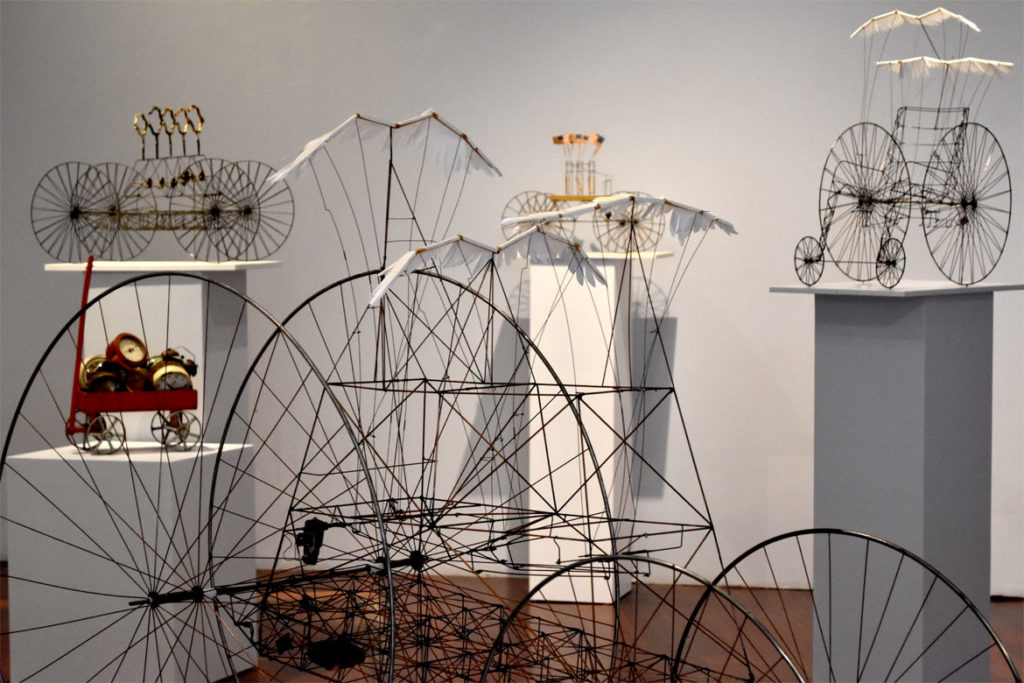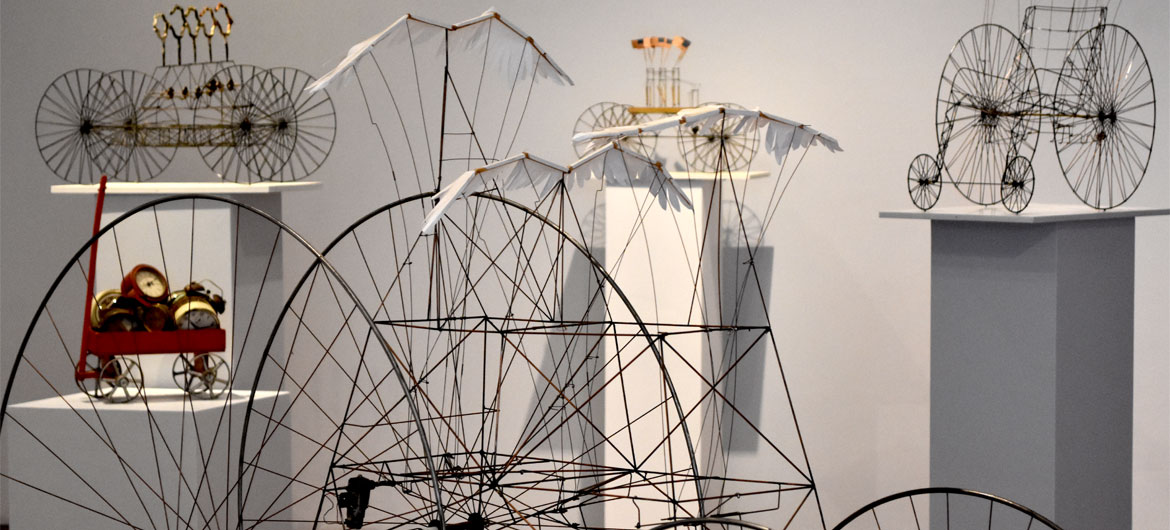“I’m particularly interested in the unexpected, unanticipated, unlikely events that can often take place in our lives,” artist David A. Lang once said.
“David A. Lang: Flights of Fancy,” at Boston Sculptors Gallery from Dec. 12 to Jan. 27, 2019, recalls the Wayland sculptor who died two years ago at age 76. (Katherine French, director of Vermont’s Catamount Arts and curator of “Flights of Fancy,” and Jessica Straus, who is also exhibiting at the gallery, are scheduled to give a free talk about the exhibitions at 2 p.m. Jan. 12.) Over the years he painted watercolors and photographed, but he was best known in his last years for the kinetic sculptures featured here—delicate wire carts topped with animated paper wings that he said came from “the realm of the unlikely.”
In a 2014 video by Paul Falcone, Lang said he dreamed up the wings while working on a wire cart that originally had little paper rockets moving back and forth on top. Instead, he began to develop a contraption that created a wiggling line of motion.
“I was fascinated by a movement like this, almost wormlike or snakelike or fishlike. Then I found if that you turn it over, and it goes backwards, it becomes a wing movement,” Lang said. “I was captivated by these rhythms.”
Like Arthur Ganson’s kinetic sculptures at Cambridge’s MIT Museum, some of Lang’s sculptures seem like jokes about life. “The Swine Flew” (2010)—”I built it for my daughter when she was sick”—features little plastic flying pigs atop a wire cart.
Other Lang sculptures are puns and meditations on political and social issues. “First Strike” (2007) is a cart topped by tiny American flags and matches that rock back and forth above a sandpaper-like surface threatening to catch fire. Lang said “Wrapture” (2010)—a straightjacket topped with flapping wings where a head should be—was inspired by “The concept of rapture … about where people leave this life and they achieve perfection with a greater being. The whole notion to me seemed to be encapsulated by people being wrapped in, imprisoned by their own belief systems.”
As Chris Bergeron wrote in the Metro West Daily News in 2011, Lang “fashions machines that act like philosophers.”
If this is the kind of coverage of arts, cultures and activisms you appreciate, please support Wonderland by contributing to Wonderland on Patreon. And sign up for our free, weekly newsletter so that you don’t miss any of our reporting.
To See Things Quite Differently
David A. Lang was born in Manhattan on July 12, 1941. His father, Harold M. Lang, was an engineer. So he grew up on Long Island “in household that was just filled with machines and parts and pieces,” Lang recalled in 2014.
Lang moved to Boston in 1964, finding work as a medical illustrator at Massachusetts General Hospital and Harvard Medical School as part of a three-year post-graduate program. The next year, he became a scientific illustrator for Harvard University’s chemistry department. He went on to teach art at the Middlesex School in Concord from 1972 to 2003. Each year during his last decade there, Lang said he taught students engineering by working with them to rebuilt old British sports cars—MGs, Austin-Healeys. He was also a licensed flight instructor for more than two decades.
During these years, Lang painted watercolors and crafted sculptures and took photographs, exhibiting at Lincoln’s deCordova Sculpture Park and Museum and Framingham’s Danforth Art Museum, where he was a founding member, and Boston Sculptors Gallery, where he became a member in 2010.
His plan for his retirement was to spend a lot of time making art in a cottage he bought in rural Ireland. But a stroke in 2004, hurt his abilities to move and think. (He had a second stroke in 2016.) The experience, he told Bergeron in 2009, caused him “to see things quite differently.”
To restore his faculties, Lang returned to sculpting. “This all began after the stroke. I found it difficult to draw and paint for several years, but was able to conceive of and build mechanical sculpture,” Lang told the South End Patch on the occasion of his exhibition “OK, Now What?” at Boston Sculptors Gallery in 2011. “Much of the work is narrative and explores the unlikelihood of day to day events and celebrates the unexpected.”
In his Natick studio, Lang engineered dreamlike contraptions of welding wire. Many of them were wheeled carts with wings or other things on top animated by motor drives, cranks, cams, worm gears, stepper motors, pulleys.
“The wheels to me represent a passage of time or passage through time or somehow having gotten from one place to another place, either forwards or backwards, or maybe just standing in time without moving,” Lang said in Paul Falcone’s 2014 video.
“As is often the case with pieces that I’m working on, I don’t find out what they’re about until they’re all done,” Lang often said.
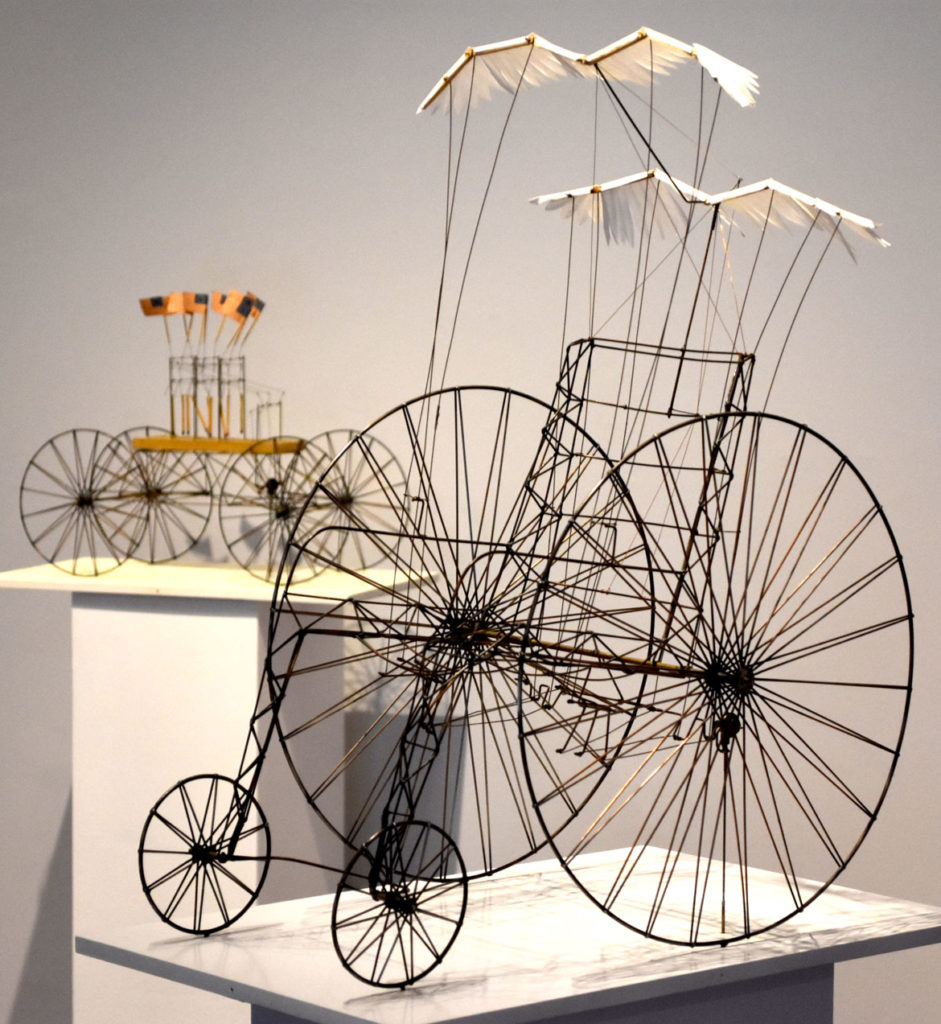
Many sculptures evoked the ravages of war or other physical and mental limitations. Wings slowly flapping above bedpans in “Fleet,” and above Korean war era army boots in “Odysseus, The Return from Troy” (2010), and above a delicate wire wheelchair in “Daedalus, On the Other Hand” (2007) seem to speak about desires to transcend the demands of tired bodies. They only go into motion when activated by light sensors and motion detectors, giving them a haunted aspect.
“I don’t sketch them out before I build them,” Lang told Bergeron in 2009. “I make them in my head and go from there by guess and by golly.”
“Straight Eight” (2007)—a wire cart topped by a row of scissors trying to cut strips of dangling paper—was inspired by a dozen children’s school scissors that he found. “I knew they were going to open and close, but I didn’t know how,” he told Falcone. He animated them, but felt like the sculpture needed something more. So he added strips of paper moving up and down above the blades, “just barely escaping.”
“The whole issue was this notion of just barely escaping,” Lang told Falcone. “I think that no matter how many times you watch a movie or a play, let’s say if you’re watching ‘Romeo and Juliet,’ it’s going to end the same way no matter how many times you watch it. Your viewing it will not change the outcome of it. …. There’s such personal involvement when people look at this, they’re rooting for the scissors or they’re rooting for the paper, and it just escapes at the last sixteenth of an inch.”
Freak Accident
“Sculptor killed in freak accident recalled as a generous mentor,” read the shocking Boston Herald headline.
On Wednesday, Nov. 8, 2017, Lang was driving his minivan north along Wellesley Street in Weston shortly before 5:30 p.m. when a car heading the opposite way crashed into a deer, throwing the animal into his windshield, according to reports in the Boston Herald and Boston Globe. His minivan flipped over. Lang was taken to Wellesley Hospital, where he died. In lieu of flowers, his family suggested that memorial gifts be sent to Brockton’s Fuller Craft Museum (where his sculpture “The Question Is The Answer” now greets visitors).
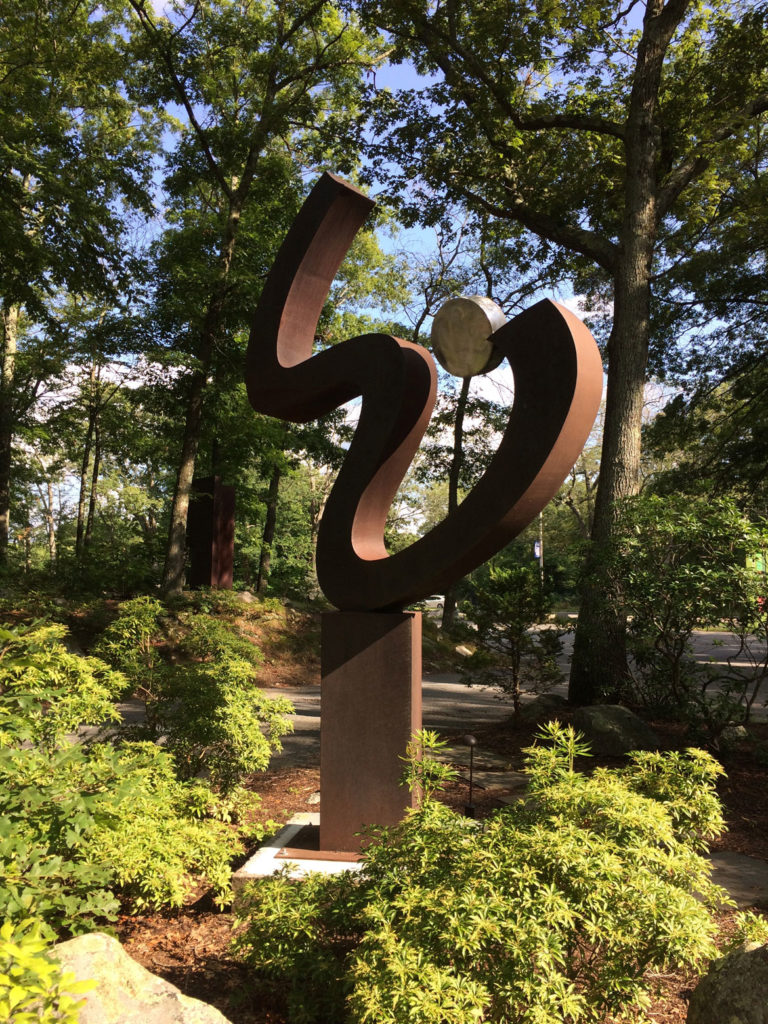
Lang had been aiming to have a show at Boston Sculptors Gallery the following spring. His last exhibition there, in May 2016, featured a single work, “Journey…” It was a 13-foot-long wire carriage suspended in the middle of a darkened room.
A tiny wooden man pedaling in the middle of the contraption seemed to be driving the wagon’s four wheels as well as three wings slowly flapping above. Projected onto the bottom of the white paper feathers were images of sky, flowing water, birds, galaxies.
Lang said the piece had gelled after a friend recommended an addition to the little man. “I put driving goggles on him,” Lang said, “and the way it affected the piece was he developed a focus, and an intensity, a passion, a forward look about hopes and dreams and possibilities.”
If this is the kind of coverage of arts, cultures and activisms you appreciate, please support Wonderland by contributing to Wonderland on Patreon. And sign up for our free, weekly newsletter so that you don’t miss any of our reporting.
